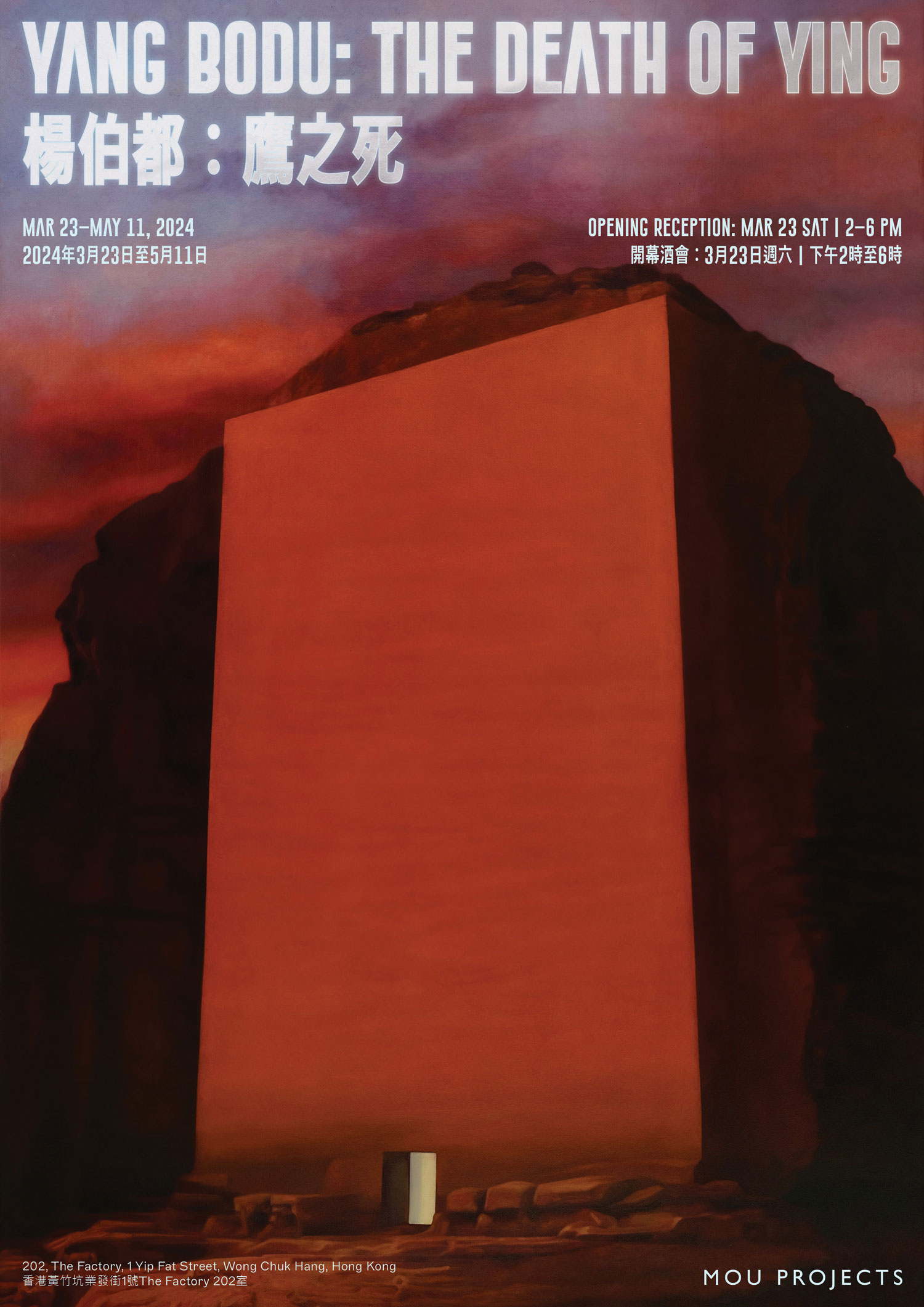展期 Period:
2024.3.23—2024.5.11
艺术家 Artist:
地点 Venue:
新闻稿 Press Release:
MOU PROJECTS欣然呈现杨伯都于画廊的第二次个展“鹰之死”。在艺术家的绘画实践中,广阔的室内空间和奇迹般的建筑景观均化身神秘庇护所,捕捉着充满戏剧性的时刻和弥漫在展览或事件空间中的“抽象氛围”。在展览“鹰之死”中,杨伯都呈现了她在过去两年中精心创作的八件绘画作品,悄然编排了一个与其《在博物馆》系列(2011至今)有微妙的不同的创作思路。展览以一种不可抗拒的亲密感和内省感为基调,探索了错综交织的个人叙事和文学片段,从而展开了一段有关执着与和解的心路历程。
展览的标题“鹰之死”使得此次展出的作品被笼罩上了一层难以言说的戏剧性和残酷性:“死”一字既指向了一种生命结局的伟大瞬间,也浓缩了这一过程背后人类生命最高形式的恐惧与坚毅、陌生与熟悉。在杨伯都近年来的艺术创作之余,她间歇地回忆与撰写了一篇有关其童年一位已故的名中带“鹰”字的绘画女老师的故事。这篇回忆录般的故事与E·M·福斯特《印度之行》(1924)中有关马拉巴山洞的描写片段交织在一起,组成了“鹰之死”的核心展览叙事。
在杨伯都的叙述中,鹰的去世是一个发生在十年前夹杂着浪漫、痛苦、追求和偏执的故事,这个遥远的场景仿佛发生在电影中的情节。展览中,三件关于玛丽莲·梦露的作品呼应了鹰这一角色,这个上世纪五十年代红极一时的美国影星作为一个时代的文化符号,其死因至今也是一桩谜团。在杨伯都勾勒出的画面中,《游龙戏凤》(1957)中舞女妆造的梦露望向画面之外的远方(《梦露》,2022–24);在黑衣人的簇拥下安详地躺在天际之下(《鹰之死—梦露 17:50》,2022–24);其名字也如电影的报幕场景般印刻在白金汉宫的景色之上(《玛丽莲·梦露》,2022–24)。梦露呼应着“鹰”,也呼应着每个女性生命历程中的一个缩影。少女之死渲染着一种骄傲与鲜艳的色彩,仿佛翱翔于天空的鹰,成为力量与自由的象征。
山洞是一个在展览中反复出现的意象,在杨伯都的笔下,它呼应着《印度之行》中的马拉巴山洞,隐喻着死亡以及一种万物归于平静的状态。在一条从门口延伸至展厅中央的狭长通道的布局下,画廊空间被构建成为洞穴的模样。通道尽头悬挂着展览的核心作品《鹰之死—山洞 20:30》(2024),在高耸的画面中,深赭色如丰碑般的建筑嵌入山体,其脚下开口处黄色的光昭示着山洞的入口。而当转入展览中心的空间内,另一幅有关山洞的作品《鹰之死—山洞 5:53》(2024)则呈现出更为温柔的景色。画面中,山洞笼罩在一阵雾气中,隐退在岩石之后,变成了一个阴凉所在,而其狭小的开口内一片漆黑,也化身为巨物之下的通向卧室的门。
在《印度之行》中,马拉巴山洞是一个奇妙的存在,无论来者对其呼喊什么,它的回应只有单调的音节:“假如先前有人在那山洞里讲粗鄙的言语,或者引述高雅的诗篇,那得到的反响一定都是相同的一声‘ou——boum’。”这个神秘空间内,消弭一切的回声象征着阶级、种族、性别的不平等皆化为无限的空无,使这个场域渲染上了一层乌托邦的色彩。或许这种归于宁静的空无也笼罩着鹰的生与死,正如杨伯都在散文中所写的那样,“先尽量完整地活下去,握住你的舵。”
MOU PROJECTS is pleased to present "The Death of Ying," Yang Bodu's second solo exhibition with the gallery. Transporting viewers into enigmatic sanctuaries of expansive interiors and architectural marvels, Yang's paintings spotlight moments of theatricality and "abstract atmosphere" that pervade spaces of exhibition or happening. In "The Death of Ying," Yang unveils a refined selection of eight paintings crafted over the past two years, subtly diverging from her acclaimed In the Museum series (2011–ongoing). Infused with an irresistible sense of intimacy and introspection, the exhibition embarks on a poignant exploration of personal narratives and literary allusions, chronicling a heartfelt journey straddling a prevailing persistence and soft reconciliation.
The title of the exhibition, "The Death of Ying," bestows an indescribable sense of drama and cruelty upon the showcased works, with the word "death" pointing to the moment of the grand finale of life's embrace, encapsulating the intertwining elements of fear and bravery, peculiarity and familiarity that lie at the core of human existence. In parallel to Yang's painting practice in recent years, she drafted an essay that recalls and pens a personal tale of her late female painting mentor from childhood, whose name carries the word "ying" (eagle). This memoir-like story seamlessly entwines with vivid excerpts from E. M. Forster's A Passage to India (1924), which centers around the enigmatic Marabar Caves. Together, these textual tapestries anchor the central theme that threads the works in "The Death of Ying."
In Yang's narrative, the demise of Ying unfolds as a tale that happened a decade ago—a distant scene akin to those plucked from the script of a mesmerizing film, interwoven with elements of romance, pain, relentless pursuit, and unyielding stubbornness. In the exhibition, three works depicting Marilyn Monroe reverberate with the story of Ying. An icon of the 1950s American cultural landscape, Monroe remains an enigmatic symbol of her era, her untimely passing shrouded in mystery. Through Yang's portrayal, Monroe appears as the enchanting performer in The Prince and the Showgirl (1957), gazing into the distance (Monroe, 2022–24); serenely lying beneath the sky, carried by shadowed figures (The Death of Ying—Monroe 17:50, 2022 –24); her name etched against the backdrop of Buckingham Palace, reminiscent of the film's opening sequence (Marilyn Monroe, 2022–24). The portrayal of Monroe mirrors the death of Ying, as well as the reflection of a woman's life course. Rendered in moments of pride and glory, the death of the girl evokes the imagery of an eagle majestically soaring through the heavens as an emblem of fortitude and unrestrained freedom.
Serving as a recurring motif throughout the exhibition, the cave symbolizes both death and a return to tranquility embodied by all things, its inspiration drawn directly from the Marabar Caves from A Passage to India. Through a narrow passageway that stretches from the entrance to the center of the exhibition space, the gallery is transformed to become a cave-like structure. At the end of the passage hangs the centerpiece of the exhibition, The Death of Ying—The Caves 20:30 (2024). The work features a monumental deep ochre architectural structure nestled within the mountains, with a soft yellow light emanating from its opening at the foot of the mountain signifying the entryway to the cave. At the center of the gallery space, another painting on the theme of the cave, The Death of Ying—The Caves 5:53 (2024), offers a more serene perspective. Within the composition, the cave is enveloped by a mist, softly receding behind the rocky mountain as a shaded sanctuary. The narrow opening, veiled in darkness, assumes the role of a gateway, leading visitors inside as if entering a private bedroom.
In A Passage to India, the Marabar Caves emit an enchanting aura. Regardless of the words uttered into its depths, the caves only deliver a monotonous reply. "If one had spoken vileness in that place or quoted lofty poetry, the comment would have been the same—'ou-boum.'" Within this enigmatic space, the reverberating echo symbolizes the eradication of societal inequalities pertaining to class, race, and gender, infusing this fictional space with a utopian vision. Perhaps the essence of Ying's life and death also finds solace within the depths of these caves, just as expressed by Yang in her essay: "First, live life to the fullest and steer your own course."

